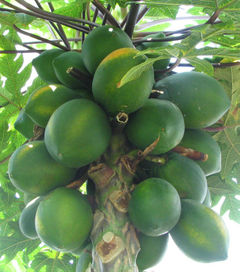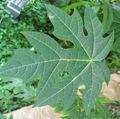| Papaya | ||||||||||||||
|---|---|---|---|---|---|---|---|---|---|---|---|---|---|---|

Papaya trunk with immature fruit
|
||||||||||||||
| Scientific classification | ||||||||||||||
|
||||||||||||||
| Carica papaya |
The papaya, also known as mamão, tree melon, fruta bomba, lechosa (Venezuela, Puerto Rico, and the Dominican Republic), or pawpaw is the fruit of the tree Carica papaya, in the genus Carica.
It is a small unbranched tree, the single stem growing to 5-10 m tall, with the spirally arranged leaves confined to the top of the trunk; the lower trunk is conspicuously scarred with the leaf scars of where older leaves and fruit were borne. The leaves are large, 50-70 cm diameter, deeply palmately lobed with 7 lobes. The flowers are produced in the axils of the leaves, maturing into the large 15-45 cm long, 10-30 cm diameter fruit. The fruit is ripe when it feels soft (like a ripe avocado or a bit softer) and its skin has attained an amber to orange hue.
Cultivation and uses
Originally from southern Mexico, Central America and northern South America, the papaya is now cultivated in most countries with a tropical climate like India and the Philippines.
The primary use of the papaya is as an edible fruit. It is usually eaten raw, without the skin or seeds. The unripe green fruit of papaya can be eaten cooked usually in curries, salads and stews.
Papaya is rich in an enzyme called papain (a protease which is useful in tenderizing meat) and other proteins. Its utility is in breaking down the tough meat fibers and it has been utilized for thousands of years in its native South America. It is included as a component in powdered meat tenderizers. Papaya enzyme is also marketed in tablet form to remedy digestive problems. Caution should be taken when harvesting, as papaya is known to release a latex fluid when not quite ripe, which can cause irritation and provoke allergic reaction in some people. The papaya fruit and leaves also contains carpaine, an anthelmintic alkaloid which could be dangerous in high doses.
Women in India and Sri Lanka and other parts of the world have long used papaya as a folk remedy for contraception and abortion. Medical research in animals has confirmed the contraceptive and abortifacient capability of papaya, and also found that papaya has contraceptive effects in men as well. Unripe papaya is especially effective, in large amounts or high doses. Papaya is not teratogenic and will not cause miscarriage in small, ripe amounts. Phytochemicals in papaya may suppress the effects of progesterone. [1]
The black seeds are edible, and have a sharp, spicy taste. They are sometimes ground up and used as a substitute for black pepper. In some parts of Asia the young leaves of papaya are steamed and eaten like spinach.
Excessive consumption of papaya, like of carrots, can cause carotenemia, the yellowing of soles and palms which is otherwise harmless.
See also
- Papaya Coconut, a 1986 hit song by Swedish pop and country singer Kikki Danielsson.
External links
- Fruits of Warm Climates: Papaya and Related Species
- California Rare Fruit Growers: Papaya Fruit Facts.
- Papaya Fruit Nutrition

Papaya leaf
|

female flowers
|

Papayas
|

tree and fruit, from Koehler's
Medicinal-Plants (1887)
|

tree and flowers, from Koehler's
Medicinal-Plants (1887)
|




 216.73.216.81
216.73.216.81 User Stats:
User Stats:
 Today: 0
Today: 0 Yesterday: 0
Yesterday: 0 This Month: 0
This Month: 0 This Year: 0
This Year: 0 Total Users: 117
Total Users: 117 New Members:
New Members:
 216.73.xxx.xx
216.73.xxx.xx
 Server Time:
Server Time: